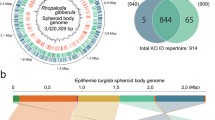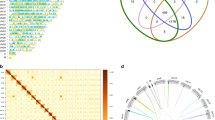Abstract
To understand reductive genome evolution (RGE), we comparatively analyzed the recently reported small genomes of two chemoautotrophic, intracellular symbionts of deep-sea clams, Calyptogena okutanii and C. magnifica. Both genomes lack most genes for DNA recombination and repair such as recA and mutY. Their genome architectures were highly conserved except one inversion. Many deletions from small (<100 bp) to large (1–11 kbp) sizes were detected and the deletion numbers decreased exponentially with size. Densities of deletions and short-repeats, as well as A+T content were higher in non-coding regions than in coding regions. Because Calyptogena symbiont genomes lack recA, we propose that deletions and the single inversion occurred by RecA-independent recombination (RIR) at short-repeats with simultaneous consumption of repeats, and that short-repeats were regenerated by accelerated mutations with enhanced A+T bias due to the absence of mutY. We further propose that extant Calyptogena symbiont genomes are in an actively reducing stage of RGE consisting of small and large deletions, and the deletions are caused by short-repeat dependent RIR along with regeneration of short-repeats. In future, the RGE rate will slowdown when the gene repertoires approach the minimum gene set necessary for intracellular symbiotic life.







Similar content being viewed by others
References
Achaz G, Boyer F, Rocha EP, Viari A, Coissac E (2007) Repseek, a tool to retrieve approximate repeats from large DNA sequences. Bioinformatics 23:119–121
Alexeyenko A, Tamas I, Liu G, Sonnhammer EL (2006) Automatic clustering of orthologs and inparalogs shared by multiple proteomes. Bioinformatics 22:e9–e15
Altschul SF, Madden TL, Schaffer AA, Zhang J, Zhang Z, Miller W, Lipman DJ (1997) Gapped BLAST and PSI-BLAST: a new generation of protein database search programs. Nucleic Acids Res 25:3389–3402
Au KG, Clark S, Miller JH, Modrich P (1989) Escherichia coli mutY gene encodes an adenine glycosylase active on G-A mispairs. Proc Natl Acad Sci USA 86:8877–8881
Boss KJ, Turner RD (1980) The giant white clam from the Garapagos Rift, Calyptogena magnifica species novum. Malacologia 20:161–194
Brudno M, Do CB, Cooper GM, Kim MF, Davydov E, NISC Comparative Sequencing Program, Green ED, Sidow A, Batzoglou S (2003) LAGAN and Multi-LAGAN: efficient tools for large-scale multiple alignment of genomic DNA. Genome Res 13:721–731
Bzymek M, Lovett ST (2001) Instability of repetitive DNA sequences: the role of replication in multiple mechanisms. Proc Natl Acad Sci USA 98:8319–8325
Dale C, Wang B, Moran N, Ochman H (2003) Loss of DNA recombinational repair enzymes in the initial stages of genome degeneration. Mol Biol Evol 20:1188–1194
Degnan PH, Lazarus AB, Wernegreen JJ (2005) Genome sequence of Blochmannia pennsylvanicus indicates parallel evolutionary trends among bacterial mutualists of insects. Genome Res 15:1023–1033
Delmotte F, Rispe C, Schaber J, Silva FJ, Moya A (2006) Tempo and mode of early gene loss in endosymbiotic bacteria from insects. BMC Evol Biol 6:56
Dyall SD, Brown MT, Johnson PJ (2004) Ancient invasions: from endosymbionts to organelles. Science 304:253–257
Endow K, Ohta S (1990) Occurrence of bacteria in the primary oocytes of vesicomyid clam Calyptogena soyoae. Mar Ecol Prog Ser 64:309–311
Frank AC, Amiri H, Andersson SG (2002) Genome deterioration: loss of repeated sequences and accumulation of junk DNA. Genetica 115:1–12
Gil R, Silva FJ, Zientz E, et al (2003) The genome sequence of Blochmannia floridanus: comparative analysis of reduced genomes. Proc Natl Acad Sci USA 100:9388–9393
Hall BG (2004) CodonAlign 2.0 published at: http://homepage.mac.com/barryghall/CodonAlign.html
Hanada K, Iwasaki M, Ihashi S, Ikeda H (2000) UvrA and UvrB suppress illegitimate recombination: synergistic action with RecQ helicase. Proc Natl Acad Sci USA 97:5989–5994
Iyer L M, Koonin EV, Aravind L (2002) Classification and evolutionary history of the single-strand annealing proteins, RecT, Redbeta, ERF and RAD52. BMC Genomics 3:8
Klasson L, Andersson SG (2004) Evolution of minimal-gene-sets in host-dependent bacteria. Trends Microbiol 12:37–43
Kuwahara H, Yoshida T, Takaki Y, et al (2007) Reduced genome of the thioautotrophic intracellular symbiont in a deep-sea clam, Calyptogena okutanii. Curr Biol 17:881–886
Li WH (1993) Unbiased estimation of the rates of synonymous and nonsynonymous substitution. J Mol Evol 36:96–99
Lovett ST (2004) Encoded errors: mutations and rearrangements mediated by misalignment at repetitive DNA sequences. Mol Microbiol 52:1243–1253
Mira A, Ochman H, Moran NA (2001) Deletional bias and the evolution of bacterial genomes. Trends Genet 17:589–596
Moran NA (2003) Tracing the evolution of gene loss in obligate bacterial symbionts. Curr Opin Microbiol 6:512–518
Moran NA, Mira A (2001) The process of genome shrinkage in the obligate symbiont Buchnera aphidicola. Genome Biol 2:Research0054.1–12
Nakabachi A, Yamashita A, Toh H, et al (2006) The 160-kilobase genome of the bacterial endosymbiont Carsonella. Science 314:267
Newton IL, Woyke T, Auchtung TA, et al (2007) The Calyptogena magnifica chemoautotrophic symbiont genome. Science 315:998–1000
Nghiem Y, Cabrera M, Cupples CG, Miller JH (1988) The mutY gene: a mutator locus in Escherichia coli that generates G.C–T.A transversions. Proc Natl Acad Sci USA 85:2709–2713
O’Brien KP, Remm M, Sonnhammer EL (2005) Inparanoid: a comprehensive database of eukaryotic orthologs. Nucleic Acids Res 33:D476–D80
Pamilo P, Bianchi NO (1993) Evolution of the Zfx and Zfy genes: rates and interdependence between the genes. Mol Biol Evol 10:271–281
Peek AS, Feldman RA, Lutz RA, Vrijenhoek RC (1998) Cospeciation of chemoautotrophic bacteria and deep sea clams. Proc Natl Acad Sci USA 95:9962–9966
Pérez-Brocal V, Gil R, Ramos S, et al (2006) A small microbial genome: the end of a long symbiotic relationship? Science 314:312–313
Rocap G, Larimer FW, Lamerdin J, et al (2003) Genome divergence in two Prochlorococcus ecotypes reflects oceanic niche differentiation. Nature 424:1042–1047
Rocha EP (2003) An appraisal of the potential for illegitimate recombination in bacterial genomes and its consequences: from duplications to genome reduction. Genome Res 13:1123–1132
Tamas I, Klasson L, Canback B, Naslund AK, Eriksson AS, Wernegreen JJ, Sandstrom JP, Moran NA, Andersson SG (2002) 50 million years of genomic stasis in endosymbiotic bacteria. Science 296:2376–2379
Thompson JD, Higgins DG, Gibson TJ (1994) CLUSTAL W: improving the sensitivity of progressive multiple sequence alignment through sequence weighting, position-specific gap penalties and weight matrix choice. Nucleic Acids Res 22:4673–4680
Tzeng YH, Pan R, Li WH (2004) Comparison of three methods for estimating rates of synonymous and nonsynonymous nucleotide substitutions. Mol Biol Evol 21:2290–2298
Zhang Z, Li J, Zhao XQ, Wang J, Wong GK, Yu J (2006) KaKs_Calculator: calculating Ka and Ks through model selection and model averaging. Genomics Proteomics Bioinformatics 4:259–263
Acknowledgment
Drs. T. Okutani, Y. Fujiwara and K. Fujikura are acknowledged for the discussion about lifestyles of Calyptogena clams.
Author information
Authors and Affiliations
Corresponding author
Additional information
Communicated by K. Horikoshi.
H. Kuwahara and Y. Takaki equally contributed to this work.
Electronic supplementary material
Below is the link to the electronic supplementary material.
Rights and permissions
About this article
Cite this article
Kuwahara, H., Takaki, Y., Yoshida, T. et al. Reductive genome evolution in chemoautotrophic intracellular symbionts of deep-sea Calyptogena clams. Extremophiles 12, 365–374 (2008). https://doi.org/10.1007/s00792-008-0141-2
Received:
Accepted:
Published:
Issue Date:
DOI: https://doi.org/10.1007/s00792-008-0141-2




